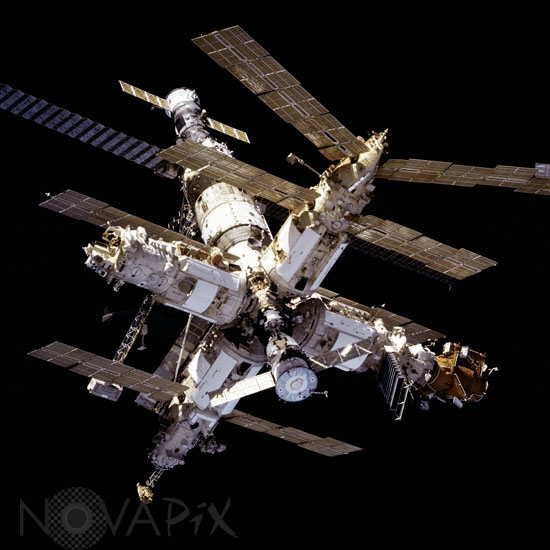Photo Agency - Astronomy - Space - Nature

Mir station seen from the shuttle Atlantis before docking 01/1997
author: Nasa/Novapix
reference: e-mir06-30000
Image Size 300 DPI: 35 * 35 cm
This is a view of the Russian Mir Space Station photographed by a crewmember of the fifth Shuttle/Mir docking mission, STS-81. The image shows: upper center - Progress supply vehicle, Kvant-1 module, and Core module; center left - Priroda module; center right - Spektr module; bottom left - Kvant-2 module; bottom center - Soyuz; and bottom right - Kristall module and Docking module. The Progress was an unmarned, automated version of the Soyuz crew transfer vehicle, designed to resupply the Mir. The Kvant-1 provided research in the physics of galaxies, quasars, and neutron stars, by measuring electromagnetic spectra and x-ray emissions. The Core module served as the heart of the space station and contained the primary living and working areas, life support, and power, as well as the main computer, communications, and control equipment. Priroda's main purpose was Earth remote sensing. The Spektr module provided Earth observation. It also supported research into biotechnology, life sciences, materials science, and space technologies. American astronauts used the Spektr as their living quarters. Kvant-2 was a scientific and airlock module, providing biological research, Earth observations, and EVA (extravehicular activity) capability. The Soyuz typically ferried three crewmembers to and from the Mir. A main purpose of the Kristall module was to develop biological and materials production technologies in the space environment. The Docking module made it possible for the Space Shuttle to dock easily with the Mir. The journey of the 15-year-old Russian Mir Space Station ended March 23, 2001, as the Mir re-entered the Earth's atmosphere and fell into the south Pacific Ocean.Â
Keywords for this photo:
1997 - CORE MODULE - KRISTALL - KVANT - KVANT 2 - MANNED SPACEFLIGHT - MIR - MODULE - PROGRESS - RUSSIA - SOLAR PANEL - SOYUZ - SPACE - SPACE STATION - SPEKTR - STS-81 -
Contact : Stéphane Aubin +33-(0)9-51-26-53-76
© Novapix - All rights reserved


